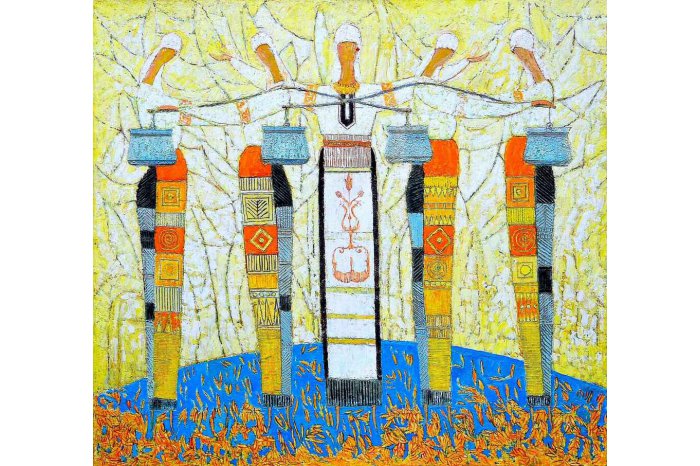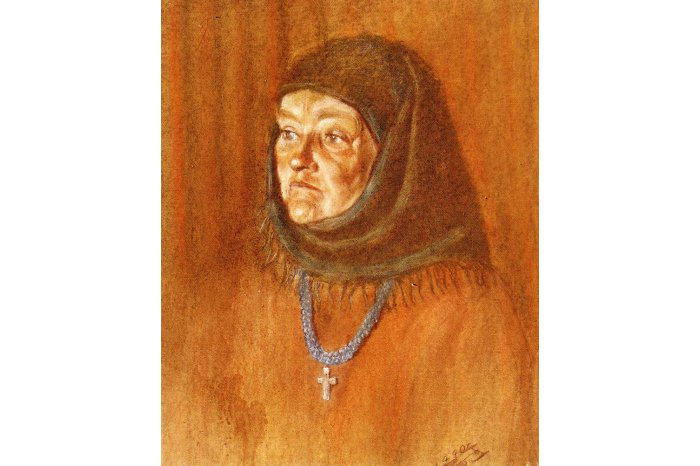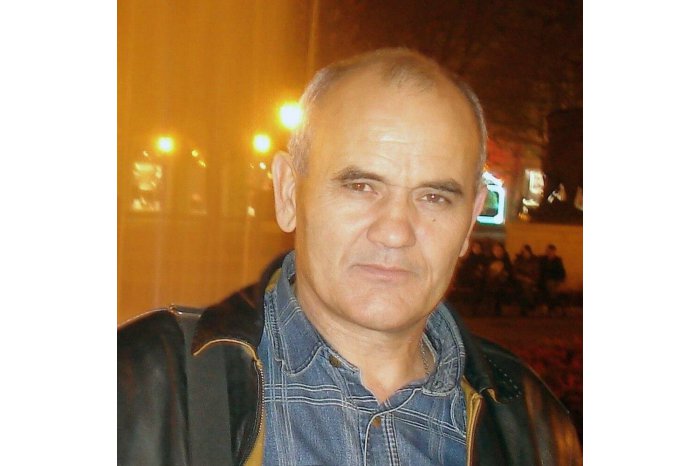Artist Aleksandr Kara: My Body Is in Bessarabia, My Spirit Is in Bulgaria!
18:01 | 06.12.2023 Category: International
Sofia, 6 dec. /BTA/. Artist Aleksandr Kara visited his homeland Bulgaria for the first time in the late 1990s. He shares that he felt great excitement at the time. "I specialized in mural painting at the University of Veliko Tarnovo. In those years I opened my first solo exhibition in Dobrich, then in Kyustendil. I visited Gabrovo, Smolyan, Malko Tarnovo. Bulgarian nature, history, people are amazing," the artist told BTA in an interview. Asked what Bulgaria means to him, Kara said: "My body is in Bessarabia, my spirit is in Bulgaria!".
Bulgarian artist Aleksandr Kara was born in 1956 in the village of Novi Troyany, Bolhrad District. He turned to painting in his childhood and devoted nearly all his free time to art. He studied at the Faculty of Arts and Graphics with K. D. Ushinsky South Ukrainian National Pedagogical University between 1977 and 1982.
He lives and works in Izmail, Ukraine. He studied mural painting at St. Cyril and St. Methodius University of Veliko Tarnovo (Bulgaria, 2003, class of D. Zaimov). Became a professor of drawing and painting at the Department of Fine Arts at the University of Izmail in 1989. Became an associate professor at the Fine Arts Department of Izmail State University of Humanities in 2015.
Chair of the city chapter of the National Union of Artists of Ukraine since 2008. Participant in international plein-air workshops and exhibitions since 1992. Has more than 20 solo exhibitions, including in Odessa (1995, 2008), the National Art Gallery in Sofia (2005), the National Assembly (2005), Crimean Republican Institution Livadia Palace-Museum (Yalta, 2007), the Consulate General of Bulgaria in Odessa (2008), the Kyiv State Historical Museum (2012). Participated in more than 160 both in Ukraine and outside the country. Honoured with 11 prestigious awards for his art, including Merited Artist of Ukraine in 2012.
Author of 43 publications, including 9 scientific, 31 creative and 3 methodological collections. Participant in the international plein air workshops Golden Orpheus (Bulgaria, 1992), Saint Luke (Bulgaria, 1996), Osojnica (North Macedonia, 1997), Tokmakli (Bulgaria, 2005) and more.
Public activist, curator of the international biennale of children's creativity Children of Bessarabia and the national plein air workshop Budjakskaya Palette since 1998. Person of the Year laureate in 2005, nominated by the Association of Bulgarians in Ukraine in the Painting category. Actively participates in international exhibitions, creative meetings of artists of the Lower Danube.
His works can be seen in a number of institutions, such as the Ministry of Foreign Affairs, the National Art Gallery in Sofia, the National Assembly, the library of the University of Veliko Tarnovo, as well as the Contemporary Art Center in North Macedonia. His paintings are also exhibited in the Izmail Art Gallery, the All-Ukrainian Centre for Bulgarian Culture in Odessa, in private collections and in galleries in Ukraine, Austria, Bulgaria, France, Germany, Canada, USA, Russia among others.
Izmail art critics wrote about him: "The artist's life includes his mother's tales that he was told throughout his childhood, the joy of his family in Novi Troyany, the landscapes of his dear Budjak, his art classes in Odessa, his touch with Bulgarian classics (in spirit, the artist is close to Ivan Milev). All this is just the visible part of creating paintings. The other side remains hidden, like magic. This magic turns us into individuals, who trust the goodness in this world, and gives us a feeling of peace under the sun. Kara's works captivate with the lightness of their subject. His paintings introduce us to the life that Bulgarians in Bessarabia live – 'a new land under a new sky'." His peers appreciate him as an original artist.
His compositions gravitate around Bessarabia. Preferred painting techniques: oil, encaustic, painting characterized by imagery, poetics, use of laconic means, combination of modern trends with the Orthodox Christian traditions of Kyivan Rus' and Bulgaria.
Each of the artist's paintings contains a piece of eternity. The artist's Bessarabian Madonnas are distinguished not by their magnificent Renaissance shapes, but by their eyes that are full of tenderness and kindness. Kara learned to paint them after studying Orthodox icons. Some experts call Kara the Bessarabian Modigliani. Like the great Italian painter, Kara painted practically no landscapes or still lifes.
Kara's successful career had him achieve universal recognition from top-level experts of the post-Soviet community and in Europe. His painting Communion was included in the album Ukrainian Painting in the Early 21st Century.
You were born in the patriarchal Bulgarian village Novi Troyany in Bessarabia. When did you start to consider painting as a possible career choice?
My native village, the Bulgarian Novi Troyany, is situated on three hills, which present a magnificent view of the Bessarabian steppe, vineyards and the Katlabukh River. All this formed my romantic perception of nature and the realities of rural life.
My father Dimitar was a creative person, he made works of decorative and applied art. He weaved on a loom, he made jugs and wooden pots.
My favourite childhood memory is the feeling I had, when my parents bought me an expensive set of drawing pencils. My childhood passion for drawing determined my goal to study at the K. D. Ushinsky South Ukrainian National Pedagogical University in Odessa. My neighbours, who had a pragmatic approach to life, were wondering: "Studying to be an artist? Go for a vet instead. Then, you will always have meat at home". Still, my parents supported me, for which I am sincerely grateful. Otherwise I wouldn't be who I am today.
I stayed true to my dream and got a degree in art. After that, I worked as an art teacher in several schools in the Tarutyne area for several years. In 1989, I started work at the then Izmail National Pedagogical Institute.
You are the author of a series of paintings, which depict themes and motifs related to the traditional life and folk calendar of the Bulgarians in Bessarabia. What inspired you?
It's all the memories of childhood. I was born and brought up in a Bulgarian traditional environment, I would call it patriarchal. And this has always manifested in my work both as a student and later. The Bulgarian spirit has been in me and with me all my life. That is why the main themes in my early work are my childhood memories of my mother and father, the way of life and traditions of the Bulgarians in Bessarabia. These are my paintings Settlers, Village Feast, Village Song, Childhood Memories, Memorial Day, Family Meal, Saint George's Day, Baba Marta, etc. The painting Horo (2008) presents the symbolism of the horo dance as a figurative and graceful embodiment of the Bulgarian national character and the emergence of unity among Bulgarians.
Female figures, more specifically the Bessarabian Madonnas, represent a significant share of your body of work.
Yes, art critics call them the Bessarabian Madonnas. The image of woman again comes from my childhood memories. The Bulgarian woman is the bringer of beauty. Female figures are imprinted in my memory as modest, slender, graceful, hard-working. Indeed, my work is dominated by female images. These are my paintings Muse, Vine, Bessarabian Girls. The figures are dressed in traditional folk costumes. My mother Ivanka Kara is an ideal of the female devotion and guardian of family harmony. Her image is present in Portrait of a Mother (1990) and is central in the triptych Woman from Troyan (1996). The female figure in the painting Threads from the Past also comes from a childhood memory of my mother weaving on a loom over the winter. Symbolism is very important to me. And I can say that the images I create are close to realism.
Your famous painting The First Furrow – On a New Land Under a New Sky is a signature piece of yours. What is the story of its creation?
The First Furrow (2015) has been exhibited in many Ukrainian and foreign exhibitions and is now in the private collection of the Bulgarian Ministry of Foreign Affairs. In it, I present an artistic embodiment of the folklore of the Bessarabian Bulgarians. The idea for this painting came about under the influence of a Christmas song recorded in Taraclia, Moldova, by Ancho Koloyanov, Ph.D., who is a professor at the University of Veliko Tarnovo. Some of the lyrics go as follows:
Green tree by a black sea
With a bird that chirps atop it.
Four oxen ploughing
With silver horns and golden mouths.
Saint Peter leads the way,
Saint George is right behind them,
The Lord is on the plough.
Mary walks ahead of them,
And while she does, she's murmuring:
May farmers see great wheat harvest,
May grape growers see lots of grapes,
May shepherds see rivers of milk!
Praise be, Holy Mary,
Praise to You and to the Lord!
The hard work of the first settlers to cultivate the steppes of Budjak, which until then knew only the animal husbandry of the Nogai Tatars, prompted those settlers to turn for help to the most revered Christian saints: Mary, Peter and George. This was the first time I came across a folk song, in which God himself was ploughing. This made a big impression on me, and I depicted it on canvas. The first Bulgarian colonists in Bessarabia believed in a better future for themselves in the new land, so their imagination formed a sacred mission that they fulfilled by living with prayer in their souls and faith in their hearts. I used elements of folk art to create the frame of this painting. The frame was made from a piece of an authentic weaving loom, the frame of a reed. The background reproduces an authentic version of the carpet as a product of Bulgarian folk weaving. Thus, the artistic concept of the painting The First Furrow reproduces a certain synthesis of my idea, of folklore and decorative applied art.
What is Bulgaria to you?
In the late 90s, I visited my ancestral homeland for the first time. I felt great excitement. I studied mural painting at St. Cyril and St. Methodius University of Veliko Tarnovo. In those years I unveiled my first solo exhibition in Dobrich, then another in Kyustendil. I visited Gabrovo, Smolyan, Malko Tarnovo. Bulgarian nature, history, people – they are amazing. To answer your question, I can only say my body is in Bessarabia, but my spirit is in Bulgaria!
Which artists would you say had the biggest influence on shaping your own artistic style?
Initially I was influenced by Russian academicism, but I gradually broke free from it. I started to look for new forms, and I think I found my own style. I am attracted to the line, iconographic deformation, symbols that are close to realism. I find it difficult to name specific artists. I have seen reproductions of Ivan Milev. He is a very interesting artist and has good works. During my visit to Kyustendil, I got acquainted with the Vladimir Dimitrov's work. I visited his studio, I saw his grave... An exceptional artist, a great master...
What are you working on now?
I am still on a Bulgarian theme. In recent years, I also created paintings dedicated to Ukraine. Some of my pieces are about the war. When the war started in February 2022, I painted a piece called Warriors of Light. It has not been exhibited yet. I have another one on this topic, but it was painted before the war. It is called Civilization Rupture. As an artist, I cannot remain indifferent and stand on the sidelines. That is why I have to show this in my paintings.



